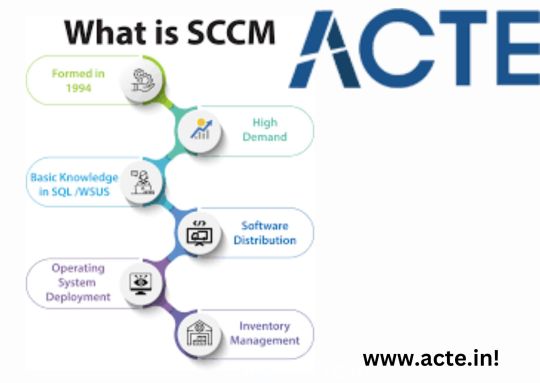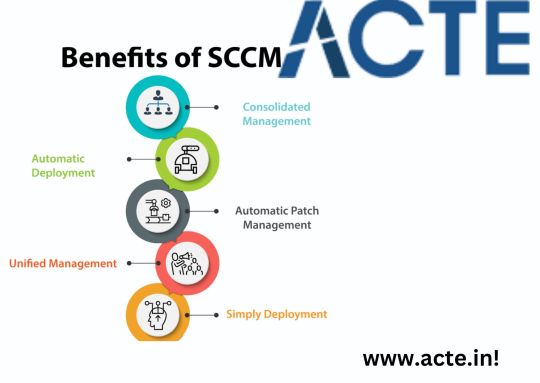Don't wanna be here? Send us removal request.
Text
Key Trends That Will Shape the Future of SCCM
In today's rapidly evolving technological landscape, businesses are constantly searching for ways to streamline their operations and enhance efficiency. One tool that has proven to be invaluable in this regard is SCCM (System Center Configuration Manager). SCCM is a comprehensive management solution that allows IT departments to automate tasks, deploy software, secure devices, and monitor system health. As we look ahead to the future, there are several key trends that will shape the landscape of SCCM and drive its continued evolution and adoption.
What is SCCM?
SCCM is a popular IT tool used to manage computers for businesses; discover how best to utilize it! Microsoft System Centre provides a comprehensive suite of products to manage IT systems across an organisation, such as software distribution, operating system deployment, patch management, network access protection and hardware/software inventory management.

IT managers rely on SCCM for managing vast arrays of systems – including virtual machines (VMs).
Benefits of SCCM:
Consolidated Management:
SCCM ensures all company PCs use identical software and rules, enabling IT managers to control all machines from a unified interface, saving time. Furthermore, updates to software or security rules across multiple machines become much simpler with SCCM’s instant implementation feature.
Automated Deployment:
SCCM automates software, hardware and security policy deployment to save manual effort and guarantee all machines run the same software and rules. This reduces manual intervention while ensuring consistency across machines.
Automatic Patch Management:
SCCM allows IT personnel to quickly and efficiently patch systems without manually checking for fixes, which helps reduce patching time as well as potential system compromise due to unpatched vulnerabilities. This minimizes both system downtime and vulnerability exposure from unreported flaws.

Simplify deployment:
SCCM allows administrators to quickly and easily create a package that can quickly deploy multiple PCs according to environment or organisation needs.
Advantages of SCCM
SCCM provides several advantages that make it an attractive solution for network and system management tasks.
Lower Costs:
It helps reduce network management expenses. Its single network license also minimizes software licensing expenses.
Strengthened Security: SCCM’s integrated security solution provides comprehensive protection for all company systems. It assists administrators in managing security patches, updates and configuration settings across all computers, monitoring system health indicators, and recognizing threats.
Enhance Visibility: Provides IT infrastructure visibility, allowing companies to monitor and manage IT assets with ease.
Achieve Delivery Speed and Efficiency: It gives administrators the speed to quickly deploy applications and updates across all systems with ease.
FUTURE TRENDS AND CHALLENGES OF SCCM
Cloud Integration:
Cloud computing is becoming increasingly important in IT management. SCCM is likely to continue integrating with cloud services like Microsoft Azure and AWS to enhance scalability, reliability, and global accessibility.
Endpoint Diversity:
The proliferation of different endpoint devices, including smartphones, tablets, and IoT devices, means SCCM will need to support a wider range of device types and operating systems.
Security and Compliance:
With the growing threat landscape, SCCM will play a vital role in ensuring endpoint security and compliance with regulations like GDPR and HIPAA. Expect to see enhanced security features and automation for patch management and threat detection.
Automation and AI:
SCCM will leverage automation and artificial intelligence to streamline routine tasks, optimize resource allocation, and improve troubleshooting. This can include predictive maintenance, self-healing capabilities, and intelligent insights.
Remote Work Support:
The rise of remote work has made it essential for SCCM to manage and secure devices outside traditional corporate networks. Expect more features related to remote device management and security.
Zero Trust Security Model:
SCCM will align with the zero trust security model, ensuring that trust is never assumed, and devices are continuously verified and authenticated before granting access to resources.

Containerization and Microservices:
Embracing containerization and microservices architecture can make SCCM more agile and scalable, allowing for easier updates and customization.
User-Centric Management:
SCCM will shift towards a more user-centric approach, focusing on delivering a personalized and seamless experience for end-users, regardless of the device they use.
AI-Driven Analytics:
SCCM will increasingly use AI-driven analytics to gather insights about device performance, user behavior, and software usage patterns to make data-driven decisions and optimizations.
Edge Computing:
As edge computing gains prominence, SCCM will need to extend its capabilities to manage and secure devices at the edge, which may have limited connectivity to central data centers.
Compliance as Code:
Compliance requirements will become more automated, allowing organizations to define compliance rules as code and apply them consistently across their environments using SCCM
Hybrid Environments:
Many organizations will maintain hybrid environments with on-premises and cloud-based resources. SCCM will need to seamlessly manage devices in these hybrid environments.
Sustainability and Green IOT:
There will be a growing focus on sustainability, and SCCM may incorporate features to help organizations manage and reduce their carbon footprint through efficient resource allocation and power management.
Multi-Tenancy:
For managed service providers and large organizations, SCCM may evolve to support multi-tenancy, allowing them to manage multiple customer environments from a single console securely.
User Education and Training:
As threats evolve, user education and training will be crucial. SCCM may offer features to facilitate cybersecurity training and awareness campaigns for end-users.
As the future unfolds, SCCM will continue to adapt and evolve to meet the ever-changing needs of businesses. The key trends such as - cloud integration, intelligent automation, enhanced security measures, and unified endpoint management - will shape the future of SCCM, driving its adoption and cementing its role as a critical tool for IT departments. By staying at the forefront of these trends, organizations can leverage SCCM to optimize their operations, enhance productivity, and achieve their business objectives with confidence.
Please keep in mind that the SCCM takes in the future may vary depending on market dynamics, customer demands, and technological advancements. To get the most up-to-date information on SCCM's future technologies and strategies.
I recommend visiting SCCM's official website or the ACTE Institute training programs covering all aspects of SCCM, providing valuable support for individuals aspiring to become SCCM Developer.
I highly recommend that you contact ACTE Institution because they offer certifications and job placement opportunities. Experienced teachers can help you learn better. You can find these services both online and offline. Take things step by step and consider enrolling in a course if you’re interested.
For More Update Just Follow My Account
1 note
·
View note